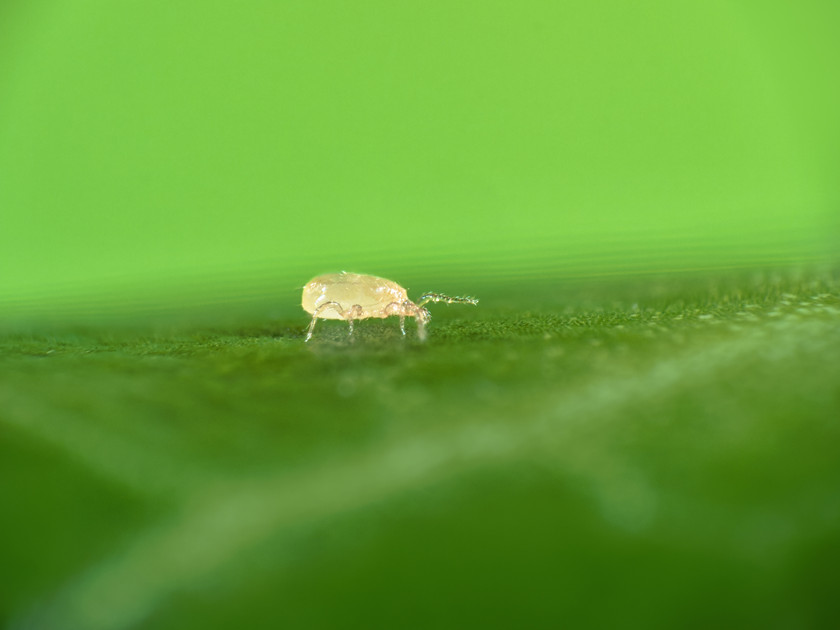Thripex — Thrips & Problem Mite Control for Cooler Environments
Oct 21, 2025
All four products use the same beneficial mite: Neoseiulus cucumeris, a Type II generalist predator. The difference is how they release and how well they handle your growing conditions.
Brand-level distinction:
Thripex is ideal for focused thrips and mite control & can be utilized in environments to cold for Swirskii. It is typically best to avoid using Thripex in combination, at the same time, as Swirskii — they compete for the same niche. Neoseiulus cucumeris is most effective at temperatures between 59 and 77°F. It is not effective at temperatures above 86°F. For warmer environments, Swirskii should be used. Neoseiulus cucumeris is sensitive to relative humidity below 70%. (Actual humidity tends to be higher than ambient readings especially near the canopy.)
Predator behavior & action:
Feeds on thrips larvae and mite species.
Prey controlled:
Western flower thrips
Onion thrips
Other thrips species
Broad mites
Other mite species
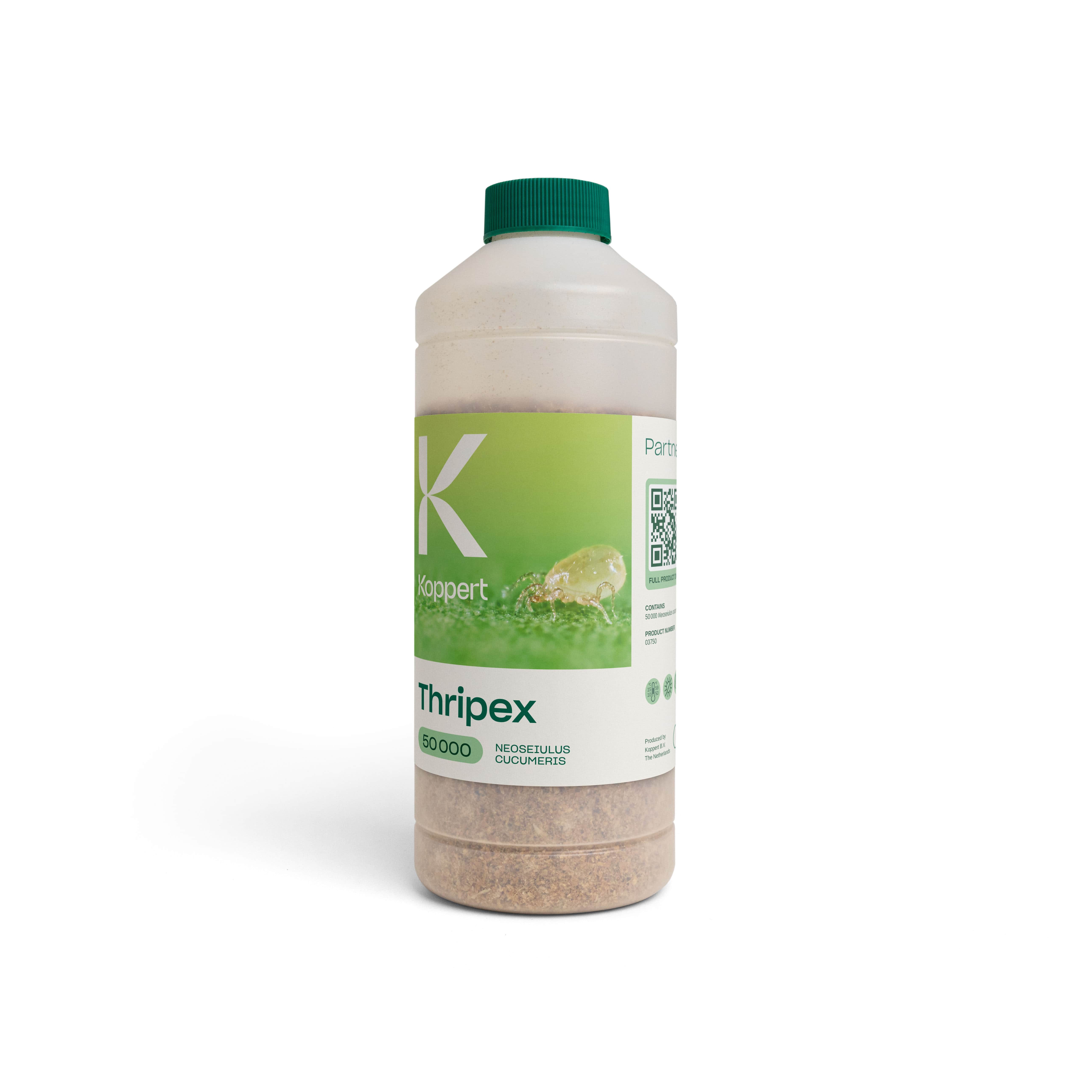
Thripex (bottle) — Fast release for active thrips or whitefly
What makes it different: Thripex bottles contain Neoseiulus cucumeris, designed for immediate dispersal onto plants. This formulation is ideal for curative use—when thrips or broad mites are already present and spreading. Unlike sachets, which release mites gradually, bottle application delivers a concentrated dose of active mites that begin hunting right away.
Best for: Situations where thrips or broad mites are already visible and pressure is increasing.
Why choose it: Immediate release means mites get to work fast. Ideal for growers who need quick, targeted control in dynamic plant environments—especially when waiting for gradual release isn’t an option.
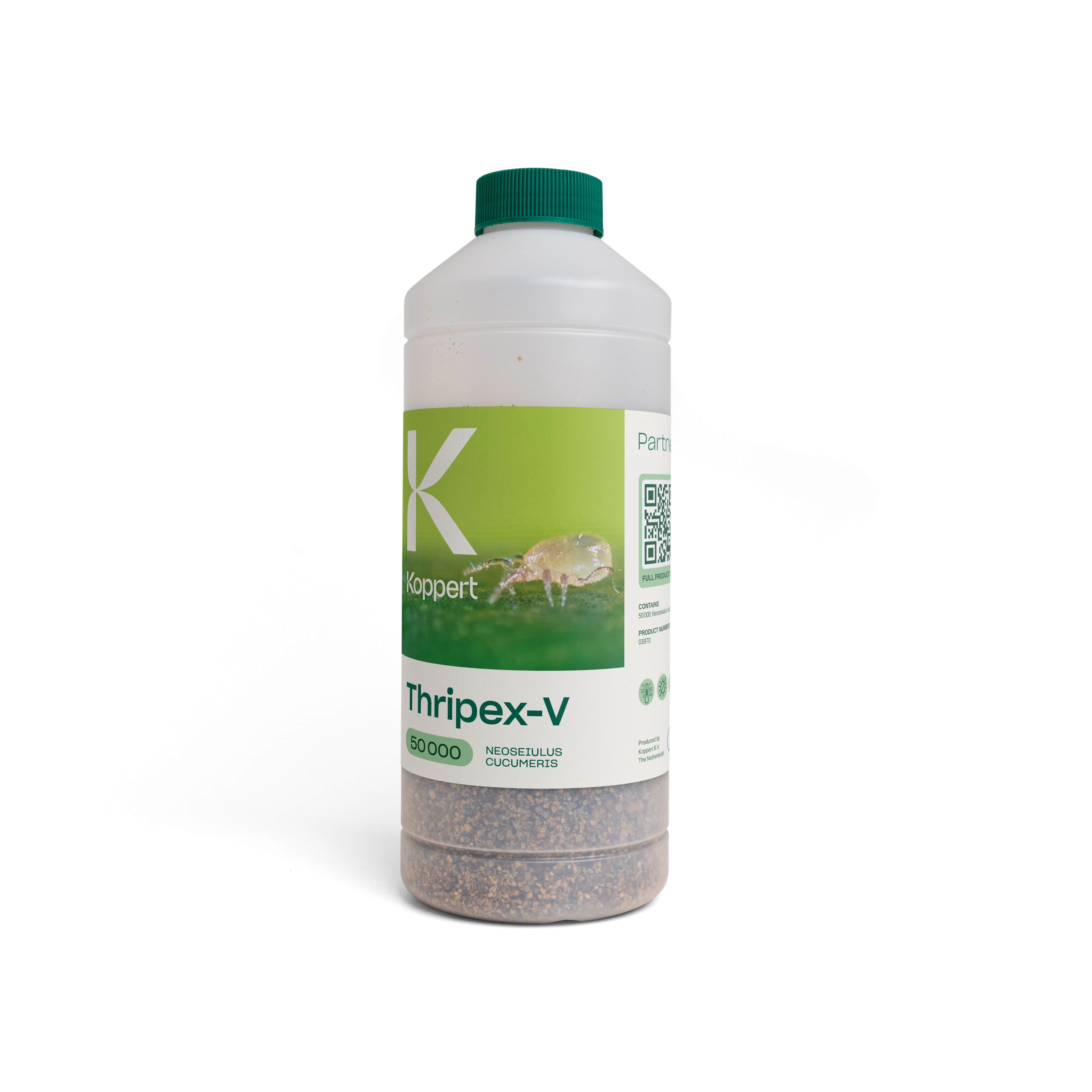
Thripex-V (bottle) — Fast release for active thrips or whitefly
What makes it different: Thripex-V bottles contain Neoseiulus cucumeris, and are identical to Thripex bottles except for the material in the bottle. Thripex-V uses a vermiculite-based carrier with minimal bran, designed to reduce the risk of mold growth after application. This cleaner formulation is especially valuable in crops like cannabis, where residue and microbial contamination can affect lab testing outcomes.
Best for: Great in cannabis and other sensitive plants where clean application is critical. Also suitable for propagation zones and ornamental setups with high humidity or strict testing protocols. For flowering cannabis, sachets or diboxes are recommended for application to avoid carrier material from getting caught in the buds of flowering plants.
Why choose it: Thripex-V offers the same biological control as standard Thripex bottles, but with a cleaner carrier that minimizes mold risk. Ideal for growers who need effective thrips and broad mite control without compromising compliance.
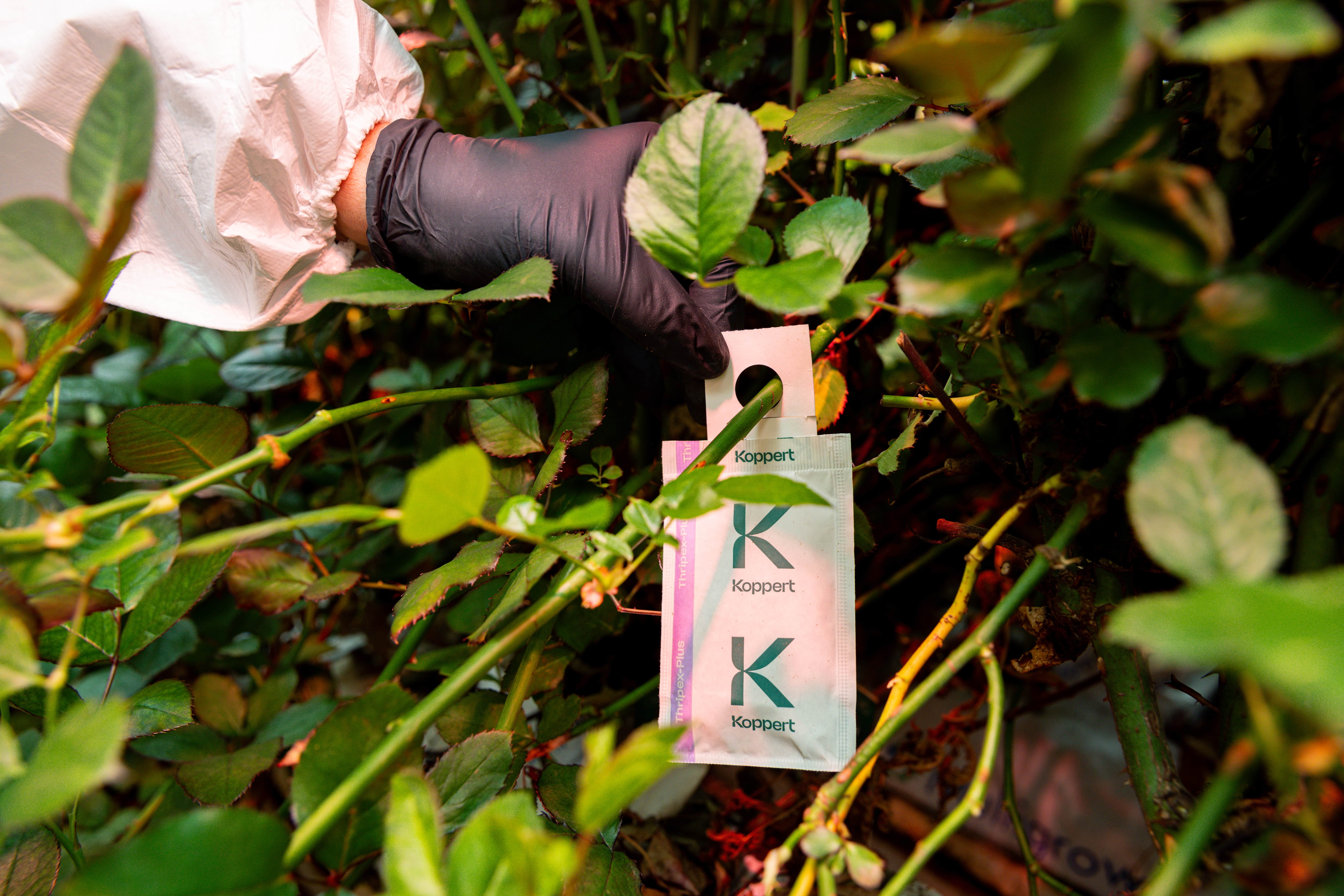
Thripex‑Plus (sachets) — Preventative control
What makes it different: Thripex‑Plus sachets use a paper-based pouch that gradually releases Neoseiulus cucumeris over 4–6 weeks. This slow-release formulation allows multiple generations to establish and maintain coverage over time. The paper sachet is sensitive to humidity and direct watering, so it performs best in stable environments where moisture levels are consistent.
Best for: Preventative use in greenhouses or indoor plant settings with steady humidity and temperature.
Why choose it: A low-maintenance way to build a lasting population before pests appear.
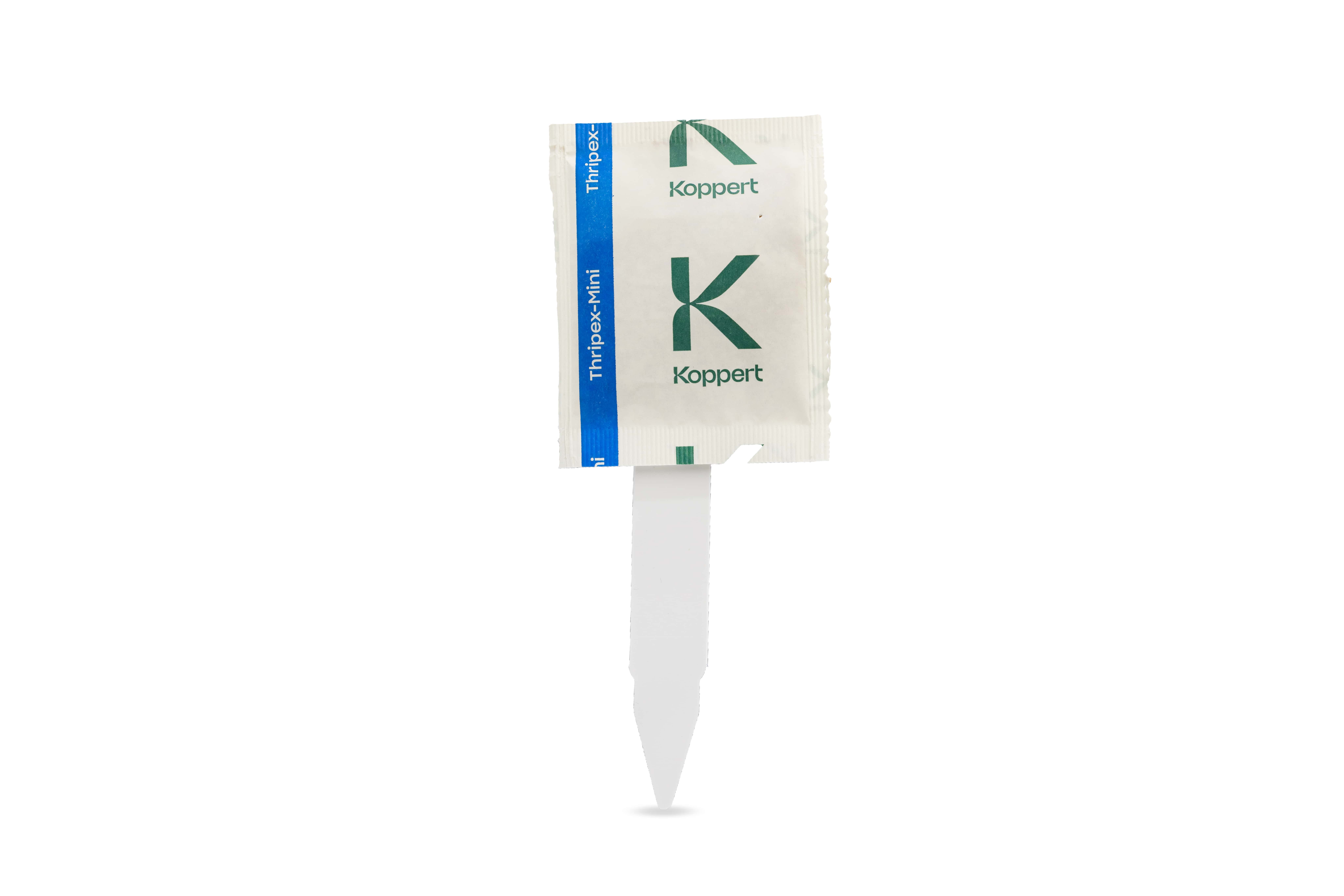
Thripex‑Mini (sachets with sticks) — Preventative control for nursery crops and short plants
What makes it different: Thripex‑Mini sachets use the same slow-release system as Thripex‑Plus & Ulti-Mite, but come with a built-in stick for easy placement in propagation trays, bedding plants, or short nursery plants. This format makes it easier to position sachets close to the plant canopy, especially in tight or low-growing setups.
Best for: Young plants, propagation zones, or any situation where hanging sachets isn’t practical. Works well in bedding flats, plug trays, and compact ornamental setups.
Why choose it: Targeted protection for low-growing plants—easy to place, long-lasting, and labor-saving. Ideal for propagation teams and nursery growers who need efficient coverage.
Quick guide
Thrips or whitefly already spreading? → Thripex (bottle)
Stable greenhouse, want prevention? → Thripex‑Plus (sachets)
Humidity swings, want prevention? → Thripex Ulti‑Mite (sachets)
Short plants or propagation trays? → Thripex‑Mini (sachets with sticks)
Thripex Quick Chart
| Pressure scenario | Choose | Why |
|---|---|---|
| Thrips or problem mites detected; quick action required | Thripex (bottle) | Immediate release for curative action |
| Thrips or problem mites detected; quick action required | Thripex-V (bottle) | Immediate release for curative action, minimizes mold risk in specialty crops |
| No activity detected; want preventative coverage | Thripex‑Plus (sachets) | Immediate action plus gradual release for sustained coverage |
| Propagation trays or short crops; want preventative coverage | Thripex‑Mini (sachets with sticks) | Gradual release for long-term coverage with stick option |
Quick Navigation back to our other top predatory mites:
Swirski‑Mite - Thrips & Whitefly Control for Warm Environments - Natural Enemies
Spical - Versatile Defense Against Mites - Natural Enemies
Spidex - The Spider Mite Specialist - Natural Enemies
For a downloadable guide to selecting the right predatory mite click here.
Check out some more information for a succesful IPM Program below:
Want to rethink how IPM fits into your bottom line?
(This article explores how Integrated Pest Management isn’t just about sustainability—it’s a smart business strategy that can improve profitability when paired with biological control.)
Need to check compatibility by beneficial predator vs active ingredient?
(A quick-reference guide for checking which beneficials are compatible with common active ingredients used in pest management.)
Looking for compatibility info based on popular spray products?
(This chart helps you identify which beneficial insects can be safely used alongside widely used commercial spray products.)
Looking for clarity on common misconceptions about beneficial insects?
(This article breaks down widespread myths about beneficial insects and explains their real-world role in biological control and plant health.)
Curious why prevention matters in biological control—even before problems show up?
(This piece challenges the idea that action only starts when something goes wrong, and explains why & how proactive strategies are key to successful growing.)

